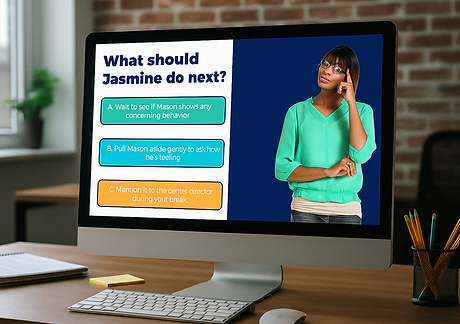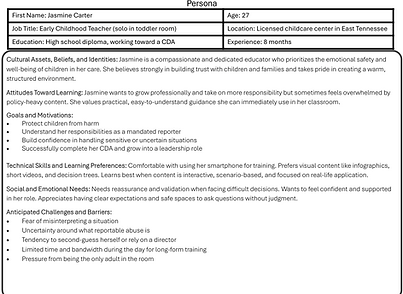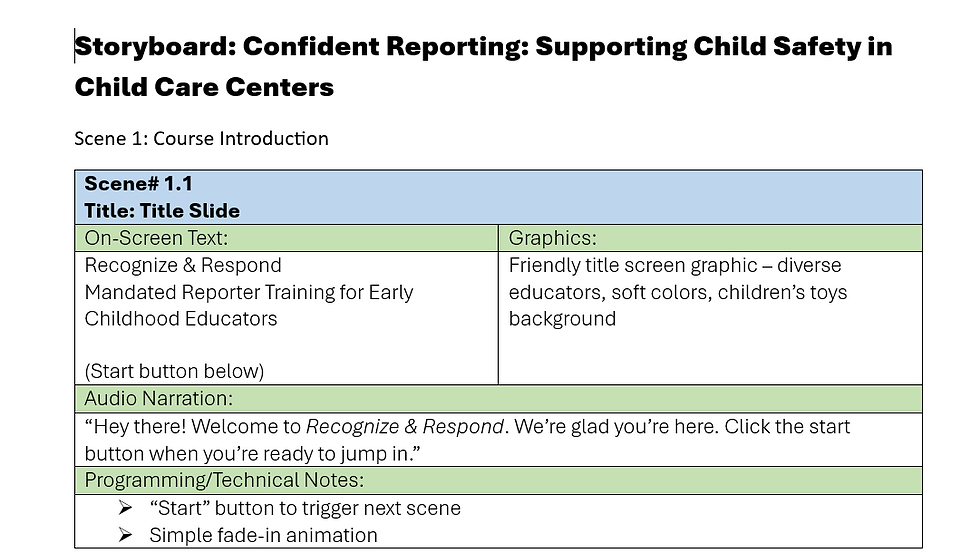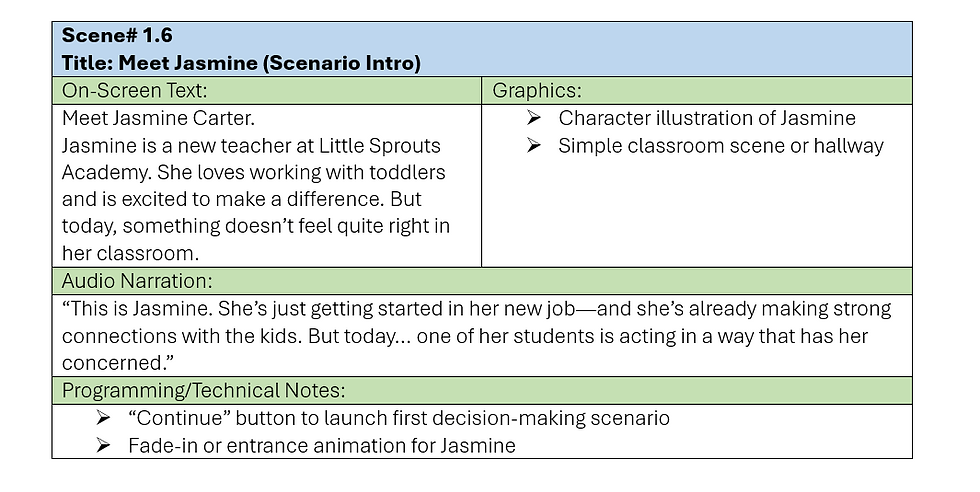Confident Reporting:
Supporting Child Safety in Child Care Centers
In this interactive training, you’ll step into real-world scenarios, sharpen your ability to spot red flags, and gain confidence in making the call that could change a child’s life. Designed for early childhood educators, Confident Reporting equips you with the clarity, tools, and support to take action—when it matters most.

The Problem
Many early childhood educators complete mandated reporter training but still feel unprepared to recognize subtle signs of abuse or navigate the reporting process with confidence. While the legal requirements are often covered in compliance courses, they rarely address the emotional weight or real-life ambiguity that educators face. This gap can lead to hesitation, uncertainty, and missed opportunities to protect vulnerable children.
The Solution
This scenario-based eLearning module was designed to go beyond compliance and build practical decision-making skills. Through interactive storytelling, realistic case scenarios, and guided reflection, learners engage with complex situations in a safe, supportive environment. The training reinforces not only what actions to take, but why they matter—empowering educators to respond with clarity and confidence when it counts most.

📚 Overview: The Design Process
This project was developed using the ADDIE model (Analyze, Design, Develop, Implement, and Evaluate), a flexible and widely used framework in instructional design. Each phase guided the creation of an engaging, scenario-based training aimed at boosting educators’ confidence in mandated reporting decisions. From identifying the real-world problem to publishing the final module in an LMS, the process was deeply learner-centered and focused on building both competence and comfort in a challenging subject area.
🔍 Phase 1: Analyze
The training began with a thorough needs analysis to define the performance gap: educators often complete compliance training but still hesitate to act when faced with possible signs of abuse. To address this, I created an empathy map and learner persona that represented a typical early childhood educator. These tools helped clarify learner pain points, motivations, and emotional context.


✏️ Phase 2: Design
During the design phase, I developed a text-based storyboard that mapped out every screen, narration, interaction, and variable logic. The storyboard allowed for clear planning and alignment with learning objectives before development began.

This opening scene welcomes the learner and sets the tone for the course. The design emphasizes clarity and approachability, encouraging early childhood educators to engage with the content from the start.

The first scenario introduces Jasmine, an early childhood educator. Learners begin to explore a realistic situation involving a child showing possible signs of distress—framing the emotional and professional stakes of the module.

This interactive decision point challenges learners to respond to physical signs of possible abuse. It encourages reflection and action, reinforcing the course’s goal of building confident decision-making in real-world situations.

This opening scene welcomes the learner and sets the tone for the course. The design emphasizes clarity and approachability, encouraging early childhood educators to engage with the content from the start.
🛠️ Phase 3: Develop
The training was developed using Articulate Storyline 360, with graphic elements built in PowerPoint and uploaded to the LMS using TalentLMS. I incorporated visual design, audio narration, interactive questions, and custom feedback paths. Each scene was designed to mirror real-life choices educators might face and included formative and summative assessment points.

🚀 Phase 4: Implement
While the full LMS course includes access restrictions and user data, the Storyline file is available to view independently as a self-contained module. This allows for full review of the course’s instructional flow, interactivity, and visual storytelling without login barriers.

📊 Phase 5: Evaluate
Learners complete a pre- and post-confidence self-assessment, along with a summative quiz. Data collected through TalentLMS will be used to evaluate effectiveness, including shifts in learner confidence and knowledge retention.
 Learners reflect on what they’ve learned and how their confidence has changed after completing the training. |  A short knowledge check to assess baseline understanding of mandated reporting before beginning the module. |  Learners rate their confidence in identifying and reporting abuse, helping establish a starting point for growth. |
|---|---|---|
 A final knowledge check measuring what learners have retained, aligned directly with the course objectives. |  Learners re-evaluate their confidence in recognizing and reporting abuse, providing insight into personal growth and training impact. |  A guided opportunity for learners to reflect on key takeaways and how they’ll apply their learning in real-world situations. |